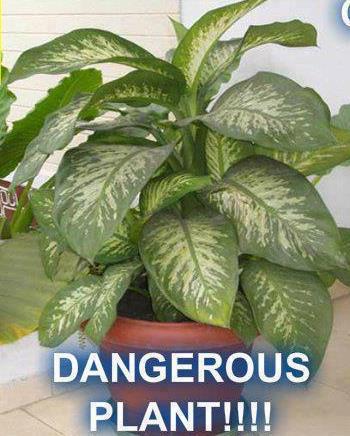A Dangerous Plant all around us
A Dangerous Plant all around us
Dumb Cane or Dieffenbachia
If you have a plant like the one in the picture above, take caution. Please be updated this plant has white patches on green leaves and not green patches on green leaves, Also the plant is protected from rodents on its own, rodents would like to maintain their distance from it. A natural therapy of the plant to protect itself, which if intervened is meant to be dangerous.
This plant is very common at our houses, gardens, parks and offices (popular as indoor & outdoor plant). The plant (Dumb Cane or Dieffenbachia) is now proven to be dangerous, so, please take care!
I know that the leaf of this plant causes itching if its sap (milk) touches your skin. But there are more dangerous facts! Read the details below.
May be useful for you. You better believe it.
Please read below.
One of my and fb friends post stated that a friend almost lost her daughter who put a piece of the leaf of this plant in her mouth and her tongue swelled to the point of suffocation. This is one plant but there are others with the same characteristics of coloring. Those are also poisonous and we should be extra cautious. Please watch out for our children. As we all leave our children at home in the hands of a nanny, we should give them a safe environment where they can play .
Name: Dumb Cane or Dieffenbachia "This plant that we have in our homes and offices is extremely dangerous!
This plant is common in Rwanda. It is a deadly poison, most specially for the children. It can kill a kid in less than a minute and an adult in 15 minutes. It should be uprooted from gardens and taken out of offices. If touched, one should never touch his/her eyes; it can cause partial or permanent blindness.
For Those who would like to know
The cells of the Dieffenbachia plant contain needle-shaped calcium oxalate crystals called raphides. If a leaf is chewed, these crystals can cause a temporary burning sensation and erythema. In rare cases, edema of tissues exposed to the plant have been reported. Mastication and ingestion generally result in only mild symptoms. With both children and pets, contact with dieffenbachia (typically from chewing) can cause a host of unpleasant symptoms, including oral irritation, excessive drooling, and localized swelling.However, these effects are rarely life-threatening. In most cases, symptoms are mild, and can be successfully treated with analgesic agents, antihistamines, or medical charcoal. Gastric evacuation or lavage is "seldom" indicated. In patients with exposure to toxic plants, 70% are children younger than 5 years. At the same time however, in different conditions there have been threatening circumstances mostly due to anxiety in mix, and of being scared.
Please be cautious is all Lone states for Lone doesnt threaten or harm nyone

Comments
Post a Comment